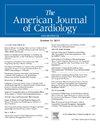Hemolytic Anemia Following SAPIEN 3 Ultra RESILIA Implantation (from the OCEAN-TAVI Registry)
IF 2.3
3区 医学
Q2 CARDIAC & CARDIOVASCULAR SYSTEMS
引用次数: 0
Abstract
Decompensated hemolytic anemia after transcatheter aortic valve implantation (TAVI) requiring specific treatment is rarely encountered in actual clinical practice. Nevertheless, there have been several cases of clinically relevant hemolytic anemia following implantation of the recently launched SAPIEN 3 Ultra RESILIA (S3UR). This study aimed to elucidate the clinical features of hemolytic anemia following S3UR implantation. Patients who underwent TAVI using S3UR from the end of March 2023 to November 2023 were enrolled from the Japanese multicenter OCEAN (Optimized CathEter vAlvular iNtervention)–TAVI registry. Hemolytic anemia was defined as (1) a drop in hemoglobin level by >2.0 g/dL within 3 months after the index TAVI procedure and (2) the diagnosis of mechanical hemolysis as the cause of anemia made by the attending physician and hematologist based on the presence of any 2 of the following criteria: (1) serum lactate dehydrogenase level >220 IU/L; (2) haptoglobin level <0.5 g/L; and (3) reticulocyte count ≥2%. Of the 1,070 patients, 18 (1.7%) patients developed hemolytic anemia after TAVI. These patients had a significantly lower prosthesis oversizing relative to native annulus (−3.7% [−5.9% to 0.1%] vs 7.5% [0.6% to 14.0%], p <0.001) and a higher prevalence of paravalvular leakage (PVL) ≥mild (mild PVL: 61.1% vs 12.4%; moderate-to-severe PVL: 16.7% vs 0.2%; p <0.001) than those without hemolytic anemia. PVL ≥mild was associated with a higher incidence of hemolytic anemia particularly in patients with oversizing of <−5% (33.3% vs 1.3%, p <0.001) and in those with −5%≤ oversizing <10% (8.3% vs 0.7%, p <0.001). In conclusion, the incidence of decompensated hemolytic anemia after S3UR implantation was not negligible, and the results of the present study support the importance of selecting a prosthesis size with a sufficient oversizing relative to native annulus to minimize residual PVL ≥mild leading to hemolytic anemia after TAVI.
SAPIEN 3 Ultra RESILIA植入后的溶血性贫血(来自OCEAN-TAVI Registry)。
经导管主动脉瓣植入术(TAVI)后失代偿性溶血性贫血需要特异性治疗在实际临床实践中很少遇到。然而,在植入最近推出的SAPIEN 3 Ultra RESILIA (S3UR)后,有几例临床相关的溶血性贫血。本研究旨在阐明S3UR植入后溶血性贫血的临床特点。从2023年3月底至2023年11月使用S3UR接受TAVI的患者从日本多中心OCEAN(优化导管瓣膜介入)-TAVI注册中心登记入组。溶血性贫血被定义为(i)在TAVI手术后3个月内血红蛋白水平下降>2.0 g/dL, (ii)主治医生和血液科医生根据以下任何2项标准诊断机械性溶血为贫血的原因:(a)血清乳酸脱氢酶水平>220 IU/L;(b)触珠蛋白水平
本文章由计算机程序翻译,如有差异,请以英文原文为准。
求助全文
约1分钟内获得全文
求助全文
来源期刊

American Journal of Cardiology
医学-心血管系统
CiteScore
4.00
自引率
3.60%
发文量
698
审稿时长
33 days
期刊介绍:
Published 24 times a year, The American Journal of Cardiology® is an independent journal designed for cardiovascular disease specialists and internists with a subspecialty in cardiology throughout the world. AJC is an independent, scientific, peer-reviewed journal of original articles that focus on the practical, clinical approach to the diagnosis and treatment of cardiovascular disease. AJC has one of the fastest acceptance to publication times in Cardiology. Features report on systemic hypertension, methodology, drugs, pacing, arrhythmia, preventive cardiology, congestive heart failure, valvular heart disease, congenital heart disease, and cardiomyopathy. Also included are editorials, readers'' comments, and symposia.
 求助内容:
求助内容: 应助结果提醒方式:
应助结果提醒方式:


